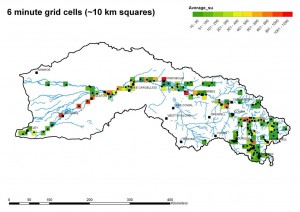
Native Fish and Fish Habitat
Many changes to the condition of the Lachlan River have contributed to the degradation of native fish habitat. River regulation has changed the flow conditions upon which many native fish depend. Changed flow patterns and degraded riparian zones increase bank erosion and turbidity and sedimentation within channels, filling pools and smothering habitats, including macrophytes, woody debris and gravel substrates (MDBC 2003).
Constant mid to low flows reduce ecosystem productivity by removing the boom (wet) and bust (dry) cues that trigger and sustain aquatic cycling. Other threats include increased runoff of contaminants into receiving waters, competition with introduced species, and structures in the river that act as barriers to movement (MDBC 2003). Some structures have been found to threaten fish directly. Fish larvae are usually poor swimmers, and travel with currents and researchers suggest that larval and juvenile fish are directly extracted from the river through pumping for irrigation and town supply. Weirs with an undershot design are also known to cause high mortality in larval and juvenile fish, for example, 95% of golden perch have been found to die after passing through undershot weirs (Baumgartner et al. 2006; DPI 2007). Releases of cold, poor quality water from the bottom of Wyangala Dam may also adversely affect aquatic habitat for many kilometres downstream (Burton and Raisin 2001).
Habitat degradation needs to be tackled at the whole river scale, as do attempts to control introduced fish, particularly carp (Humphries et al. 2002). The Lachlan Carp Strategy, also known as Lachlan River Revival, is the basis for controlling carp within the Lachlan and investigates a variety of methods to reduce carp numbers. The Lake Brewster Fish Management and Operations Plan and Draft Lake Cargelligo Fish Management and Operations Plan also provide guidance on how to better provide for native fish in wetland habitats through improved management. The effective implementation of the Lake Brewster Fish Management and Operations Plan is also important in protecting the only known population of olive perchlet in the southern Murray-Darling Basin, found in Brewster Weir pool and Mountain Creek.
The composition (richness, relative abundance, and biomass of pest species) of a fish community found at a particular site or within a particular creek of the Lachlan is likely to be influenced by a combination of local habitat characteristics, recent and historical flows and the longitudinal and lateral connections to habitats, including the floodplain (Jenkins et al. 2004). As fish cannot disperse to other catchments (e.g. waterbirds) or become dormant (e.g. plants, frogs) as habitats dry out, they are dependant on permanent water remaining accessible. This makes fish dependent upon permanent water remaining in river and creek channels to a much greater extent than other species. Regular and frequent environmental flows are also required to maintain functionality within permanent fish habitats, unlike most wetland habitats which can maintain functionality after many months of complete drying.
Native fish species in the lower Lachlan tend to recruit during spring and early summer. During this critical time, appropriate flows are needed to induce spawning, protect eggs and promote larval and juvenile fish survival. Warmer temperatures during this period are important for most species. Providing suitable flow conditions during these critical larval rearing stages followed by reduced summer irrigation flows to prevent wash out of larvae and prey from nursery habitats is vital (Humphries et al. 20028). Restoration of late winter-spring floods would provide optimal feeding and growth conditions for adult fish before spawning as well as providing floodplain habitats with a rich supply of food for larval and juvenile fish (Gehrke et al. 1995).
As fish cannot disperse to other catchments, like waterbirds, or become dormant, like plants or frogs, as habitats dry out, they are dependant on permanent water remaining in river and creek channels to a much greater extent than other species. A number of important fish habitats have been identified in the Lachlan including the Lachlan River around Warroo Bridge, the Lachlan River and Goobang Creek near Condobolin, the Lachlan River and Mountain Creek near Brewster Weir and the Lachlan River between Gonowlia and Booligal Weirs. The map of the catchment below shows areas that are most important for fish, indicated by the red squares. These scores are based upon abundance and diversity of native fish determined from years of fish sampling by NSW Industry and Investment (Fisheries).

Native Fish Survey Results (source: NSW Industry and Investment)
The NSW Government have listed the aquatic ecological community of the lowland Lachlan River as endangered – see the end of this section for further information. For this purpose the lowland Lachlan River has been described to include all natural rivers, creeks, streams and associated lagoons, billabongs, lakes, wetlands, paleochannels, flood-runners, floodplains and distributary streams of the Lachlan River downstream of Wyangala and the Belubula River downstream of Carcoar Dam. The list of species of interest is outlined in the table below.
| Species | Vulnerable | Endangered | |
| River Snail1 | Y | ||
| Silver Perch | Y | ||
| Macquarie Perch1;2 | Y | ||
| Murray Cod | Y | ||
| Trout Cod | Y | ||
| Purple-spotted Gudgeon | Y | ||
| Southern Pygmy Perch | Y | ||
| Olive Perchlet (western population) | Y | ||
| Eel-tailed Catfish (MDB population) | Y | ||
| Flat-headed Galaxias (last collected from Lake Brewster in 1970s) | Y | ||
1 Listed under NSW Threatened Species Conservation Act 1995 (NSW TSCA) 2 Listed under Commonwealth Environmental Protection and Biodiversity Conservation Act 1999 (EPBCA)
